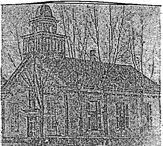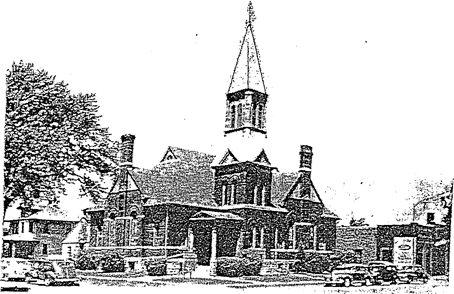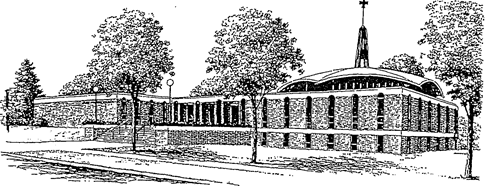HISTORY OF THE OSCEOLA UNITED METHODIST CHURCH
Compiled by Fern Underwood from records kept by Melvin Goeldner
1854; Osceola, Iowa, a settlement of seven houses, was three years old. The Rev. Mr. Davis formed the Methodist Episcopal Society with 12 members: Dickinson and Louise Webster, L.D. Sr., Joanna, and Elizabeth (Lizzie) Fowler, Martha Jenks, Mr. and Mrs. E. A. Lantham, George and Jane Christy, Mr. and Mrs. John Shearer. (Another records lists Mrs. Gardner, Miss Winkle [or Winkler], and Miss Almina Lampson.) Services were generally held in a school house on Cass and Adams Streets, or in the old frame courthouse on the north side of the square. Sunday School was organized and met in a room on the east side of the square.
 1856-1860: The first church edifice, painted white, was completed at a cost of $6,000. It was situated on the west side of Main Street one block south of the square. It was eventually moved to the east side of the street and became an opera house. On Dedication Day, July 10, 1864 all bills paid, the balance in that account was $3.58.
1856-1860: The first church edifice, painted white, was completed at a cost of $6,000. It was situated on the west side of Main Street one block south of the square. It was eventually moved to the east side of the street and became an opera house. On Dedication Day, July 10, 1864 all bills paid, the balance in that account was $3.58.
1860: Seminary established discontinued 1864.
1865: Reed organ used for Sunday School regarded as "machine music" by some. The Sunday School celebrated Christmas with a huge tree bearing a gift for every member. Sixth session of the Des Moines Conference was held at Osceola.
1870: Report by Pastor McIntire: Membership 200, sexton debt of $35, the organ worn out, the old Record used up. The following year, after a Mush and Milk Festival: net proceeds $100. New organ bought $300. Record $9.00. Sexton paid. Debt of about $250 against parsonage being paid by selling lots in the graveyard, the idea credited to J. 0. McAuley. Added 28 members, 35 probationers.
1874: Sexton employed for $12 per month to keep the church building clean...lamp flues well cleaned, wicks well trimmed...to warm up and light said church building at all times that is required for the services of the Society of said church. To paste on from time to time any and all papers (which) become loose on the walls...to see that no property belonging to said church go to waste, to ring all the bells necessary, to cut wood to suit the stoves, to see that order is kept in said church at all times.
1876: Women's Foreign Missionary Society organized.
1882: AME (African Methodist Episcopal) Church organized.
1889: Chapter of Epworth League organized.
1892: Junior League organized.
1893: The Ladies' Aid Society organized to "assist the pastor in visiting the sick, non-church goers, newcomers, and to raise money in whatever way and for whatever purpose the society may deem proper...Gentlemen may become honorary members on paying dues of 50¢ a year."
1894: During the pastorate of Rev. David Shenton, plans for a new church at 230 South Main were promoted and approved. The cost apart from the lot exceeded $10,500. Dedication, November 18, 1894. (A report from the Fair Association, "This is a first class fruit country with a school house on every hill and not a saloon in the county."
1904: Jubilee Day - cancellation of mortgage. Church debt free.

1905: Motion in Ladies' Aid Society to buy a looking glass for the vestibule failed.
1907: Ladies' Aid served lunch to 125 Woodmen. Menu: ham, deviled eggs, baked beans, potato chips, cheese, pickles, coffee, ice cream and cake for 35¢ a plate. In 13 years they raised
$1,000 for the church building, $275 for carpet, $50 for window and subscribed $500 at the dedication of the church.
1911: New parsonage began 1910, constructed and paid for.
1913: Ladies' Aid voted to carpet the church. Cost $423.80.
1914: Church remodeled and completely modernized. The cost ($5,000) was more than met by the day of reopening December 28.
1916: Pipe organ paid for according to Ladies' Aid report.
1923: Proposal to publish list of members and friends of the church and suggested amounts needed to meet church obligations. Picture machine sold for $300.
1939: Union of Methodist Protestant, Methodist Episcopal Church South, and the Methodist
Episcopal Church.
1940: Woman's Society of Christian Service organized.
1952: Separate building erected as Sunday School annex was dedicated.
In 1951 Centennial issue of the Sentinel showed ten church buildings in the community: First Methodist, Assembly of God, Immanuel Lutheran, First Christian, First Presbyterian, Community Bible, Seventh Day Adventist, AME (African Methodist episcopal) Branch of the Methodist Church, Foursquare, and St. Bernard's Catholic.

1954: Rev. Azel Smith was the pastor when the congregation celebrated the 100th anniversary. To correct the notion that pastors work only one hour a week, Rev. Smith's annual report showed 138 sermons requiring 1200 hours of preparation, 1585 calls,
23 weddings, 59 funerals, 27 adult baptisms, 12 infant baptisms, 57 counseling sessions (300 hours), 45 sessions teaching Bible study class and 4 sessions teaching the WSCS (Women's Society of Christian Service) study, 18 outside speaking engagements in addition to participating in numerous civic functions.
1956: Formation of Quilters. They gave all the proceeds of their work toward a building fund.
1960-1964: Pastorate of Rev. George Pennington. 1964-1976: Bishop James S. Thomas.
1960: During Rev. George Pennington's ministry, the parsonage was sold and moved to 717
South Jackson. George and Minerva lived in an apartment until a new parsonage was built. At that time there were five Methodist churches in Clarke County: Osceola, Lacelle, Murray, Thayer, and Woodburn. It was estimated that 43% of the population were unchurched; 22% of Osceola membership attended on an average Sunday.
1961: The congregation determined that the former brick structure had deteriorated to a point that made it impractical to restore. Land was purchased where South Ward School had stood on the comer of West Grant and Fillmore. A new parsonage was built at 531 South Fillmore on grounds purchased from the Clarke Community School.
1962: Fund drive began for $150,000 for new church.
1964: Pastorate of Earl Nelson
1964: Interchurch Council, made up primarily of lay women, functioned as extension of the
Ministerial Alliance, addressing concerns of broader scope than any one congregation.
1965-1971: Pastorate of John Wesley McCallum.

1966: September 11: Led by Administrative Assistant to Bishop Thomas, Dr. Fred Miller, District Superintendent Dr. Everett Staats, Rev. John McCallum, and the choir, the congregation marched to the site of the new church building, where South Ward School formerly stood, for the ground breaking ceremony.
Building committee members: R. K. McGee, Mrs. Fred DeHaan, Mrs. C. E. Tindle, Richard Touet, Glen Poore, Noel Friday, Melvin Goeldner, Ron Ogan, and Pastor John McCallum.
1966: Relinquished use of Annex to Snowdon's factory. Loan of$180,000 needed for the building program negotiated with National Board of Missions and Clarke County State Bank.
1968: Consecration Service January 28. Participating were Rev. John McCallum, Rev. George
Pennington and District Superintendent Everett H. Staats.
1968: Sales of former church building to Snowdon factory. Five of the stained glass windows are in the Clarke County Historical Museum.
On April 23, 1968 the Plan of Union became effective, uniting the Evangelical United Brethren Church with the Methodist Church thus creating the United Methodist Church. A Service of Celebration united the women of the former Evangelical United Brethren and women of the former Methodist Church with the stated purpose, "To help women grow in the knowledge and experience of God as revealed in Jesus Christ and to challenge them to respond to God's
redemptive purpose in the world."
1971-1978· Pastorate of Rev. Ivan C. Bys. Bishop Lance Webb
1972: Parsonage renovation. (Painting, carpeting, drapes, ceramic tile in kitchen, stove hood, and air vent.)
1973: Women's Society for Christian Service renamed United Methodist Women. The congregation participated in "Key 73", "Calling our Continent to Christ."
1974: Began Prayer Fellowship 7:00a.m. each Wednesday at uptown cafe. Five members of the congregation went to Israel for the World-wide Consultation on Evangelism.
1975: May 18: Dedication of new church and mortgage burned. Presiding at the service were
Pastor Ivan C. Bys, District Superintendent Frank Nichols, and Rev. John McCallum.
1978-1983: Pastorate of Rev. Richard Eis. 1980-1984. Bishop Wayne Clymer.
1979: Church air conditioned.
1980: The family of C.D. Friday erected a tower for the bell from the 1854 church building.
1981: The Osceola Chapter of the United Methodist Men organized. Church library begun.
Maude Merritt left a sizeable bequest which initiated the formation of the Osceola United Methodist Foundation. Later additions were left by Richard A. Robinson, 1988, and Doris Kimzey in 1973. Many expenditures have been taken from interest money generated by the investment of Foundation funds, both pertaining to the church building, office, and parking lots; and contributions to community interests: significant support of additions to the Osceola Public Library, playground equipment for Clarke Elementary School, purchase of the Senior Center building, and the DARE program.
1983-1992: Pastorate of Rev. Clifford Haider. 1984-1992. Bishop Rueben Job.
1983: New surface on church dome, roof work completed, inside repainted, drainage problem corrected, and broken and chipped exterior bricks replaced.
1984: Purchase and dedication of new Rodgers organ.
1987: Church study by Dr. Kennon Callahan.
1988: Educational Assistant added to staff. Computer purchased.
1989: Parsonage refurbished. Purchase of lot adjoining parsonage. Cost of lot and associated expenses, approximately $40,000.
1991: Built shelter house at Q-Pond Park. Purchased Risograph office machine.
1992-1995: Pastorate of Rev. Judith K. Miller. 1992-2000: Bishop Charles Wesley Jordan
1992: Additions to staff: Parish Visitor, Youth Director. Re-carpeted sanctuary, narthex, nursery, and offices. From second semester, 1992 through May 1994, school classes were held in church basement while the construction was completed on the new Elementary building.
1993: Began Fall Harvest Dinners and Auction
1994-1995: The proposed construction of a Lakeside Casino became a divisive issue.
1995-1997: Pastorate of Rev. L. Duane Churchman.
1995: New roof, addition to parsonage garage.
1996: First edition of Recipes for Living life stories.
1997: UMW (United Methodist Women) revised meeting schedule to accommodate changes in
women's lifestyles.
1997: Pastorate of Rev. James Louk. 2000: Bishop September, 2000: Gregory V. Palmer
1998: Foundation by-laws revised. New phone system, office furniture, computer system, and fax machine installed. New sound equipment. Began direct deposit for giving. Vision Committee formed. Country Store added to Harvest Dinner and Auction.
1999: New Bibles and hand bells purchased and choir formed. Ecumenical Youth Group and Fun
Church begun. Coffee Shop added to Harvest Dinner and Auction.
Return to main page for Recipes for Living 2000 by Fern Underwood
Last Revised August 24, 2012
 1856-1860: The first church edifice, painted white, was completed at a cost of $6,000. It was situated on the west side of Main Street one block south of the square. It was eventually moved to the east side of the street and became an opera house. On Dedication Day, July 10, 1864 all bills paid, the balance in that account was $3.58.
1856-1860: The first church edifice, painted white, was completed at a cost of $6,000. It was situated on the west side of Main Street one block south of the square. It was eventually moved to the east side of the street and became an opera house. On Dedication Day, July 10, 1864 all bills paid, the balance in that account was $3.58.

